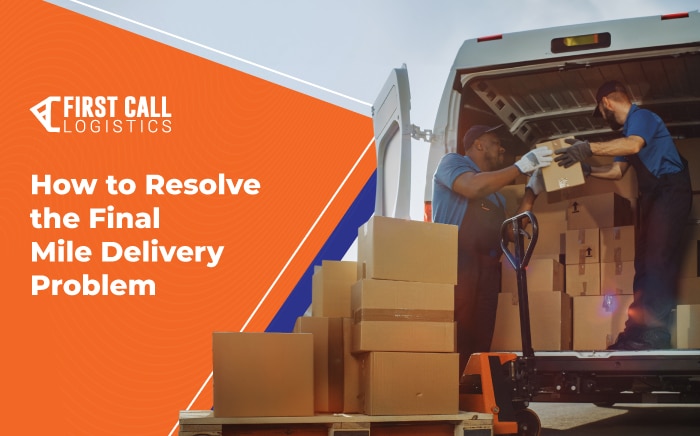How to Resolve the Final Mile Delivery Problem

As the industry seeks new ways to optimize shipping practices, the single biggest opportunity for growth and efficiency lies in what is often termed final mile delivery — the last leg of a product’s journey from the warehouse to the customer’s doorstep. Here’s why it’s critical to understand the inner workings of final mile delivery, why it still poses such a challenge to shippers, and strategies to ultimately reduce final mile costs.
What Does Final Mile Delivery Cost?
Getting a product 90% of the way to a consumer is easy — at least relative to the final 10% of the journey. Transporting goods in large volumes across interstates can be distilled down to a fairly simple, efficient process. However, taking individual packages to individual addresses continues to represent the most expensive (and most time-consuming) segment of the delivery process, and as e-commerce sales continue to soar, this becomes increasingly apparent. The last leg of product delivery reportedly accounts for 53% of total shipping costs.
To make matters worse, the rise of domestic e-commerce sales is expected to continue its steep trajectory. More parcels are delivered each day to more locations, both urban and rural, each with its own set of unique challenges. While companies like FedEx and UPS attempt to offset the cost of delivery by hiking shipping rates, free shipping remains a relatively set standard established by Amazon and other large-scale companies with hundreds of fulfillment centers at their disposal.
This is the final mile problem. How do you get every customer’s goods in the right hands in a timely manner with optimal efficiency? And how can businesses convert the final mile issue into an opportunity to slash shipping costs with improved shipping methods?
The Current State of Final Mile Delivery
As giants like Amazon continue to normalize speedy (and often free) shipping, the scramble to keep pace is taking on many forms. E-commerce sellers often rely on 3PL companies to complete deliveries, but the landscape for order fulfillment and final mile delivery is hardly consistent. Online sales are on the up, shipping costs are rising across the board, and businesses experiencing exponential growth are being forced to find new methods of achieving optimal delivery to an increasingly impatient clientele.
Some enlist the help of regional carriers or even the USPS for the last leg of delivery, while others entrust their goods with enterprising independent drivers who make themselves available through Uber, Postmates, and other means.
Crowdsourcing last-mile deliveries raise some concerns over reliability and preserving the customer experience compared to more traditional means, but today’s environment makes it possible for just about anyone with a license and a vehicle to aid shippers in getting goods to their final destination. The challenge is determining which of these independent shippers can be relied upon, for how long, and for how much capacity before it becomes more cost-effective to simply ship via in-house methods.
Strategies to Reduce Final Mile Costs
Shippers are already attacking the final mile problem from all sides. Cutting costs and improving delivery times is so much a necessity in today’s e-commerce-heavy environment, some shippers are teaming up with competitors to share the burden of fast transport and minimize costs for final delivery.
Innovative technology also plays a major role in reducing shipping costs. Advanced warehouse management software (WMS) allows businesses to keep a watchful eye on inventory and supply chain efficiency. Pairing warehouse management systems with decentralized warehouses can further amplify the positive effects of both.
Housing products closer to the end consumer by maintaining regional fulfillment centers allows businesses more flexibility and adaptability when maneuvering within tight shipping windows. Strategically-placed fulfillments centers make next-day and even same-day shipping a more cost-efficient offering.
Warehouses are far from the only places employing technology to streamline shipping costs. Many 3PL providers and fulfillment centers apply complex algorithms to estimate traffic and weather patterns that might obstruct on-time shipments.
Particularly in cases of food and perishable goods, it’s become increasingly common for logisticians to employ programs to locate the best shipping routes around potential hazards. Customers concerned about the latest on their orders can use similarly advanced tracking software to receive regular status updates from initial shipment to completed delivery.
There’s no one magic bullet to solve the final mile problem, but there are several small ways to earn an edge in cost-effective shipping. While potential technology like drone delivery and self-driving cars may be somewhere on the horizon, the current state of shipping requires intense preparedness and efficient management of inventory at every phase of the delivery process. Rapid and cost-effective shipping is possible, but it will likely take multiple tools in the logistical belt to keep up with user demands.
Partner With First Call for All Your Final Mile Delivery Needs
In today’s fast-moving marketplace, businesses need the ability to react quickly to market conditions. Well-versed in the challenges of final mile logistics, our team will work to create a strategy that ensures your products are delivered on time safely. To learn how our growing network of B2B warehousing services, best-in-class technology, and extensive carrier network can provide your organization with supply chain efficiencies and cost savings year-round, contact us today.
Simplify your Next Shipment with First Call Logistics
Building and managing cost-efficient supply chains is a full-time job. First Call’s rare combination of in-house assets, expert problem-solving and track record of stellar customer service makes us the 3PL of choice for business partners with a wide range of shipping needs.
More Resources for FCL Shippers:
- Article: Trends & Innovations in Final Mile Delivery Services
- Article: Benefits of Dedicated Transportation Strategies
- Article: Meeting Unique Needs with White Glove Delivery Services
- Article: The Ins and Outs of Expedited Freight Shipping
- Article: Understanding Partial Truckload and Volume LTL Shipping
- Article: Optimize Your Supply Chain with Decentralized Warehousing
Get the latest supply chain news and updates directly to your inbox.